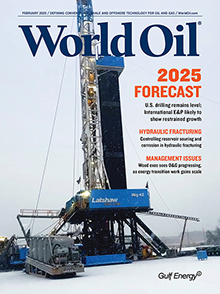Issue: February 2025
SPECIAL FOCUS: 2025 Forecast & Review
It’s been an odd start to 2025. Amid stronger underlying factors, the Canadian oil patch normally would be gearing up to bolster production. But with the federal government in disarray amid threats of a damaging trade war from the U.S., uncertainty remains the only constant.
The outlook for international E&P remains mixed, with a slight gain in drilling expected. Four of eight regions will be up, three will be down, and the Middle East will be flat. South America and the Far East/South Asia are the stand-outs. Offshore activity will fare better than onshore work.
U.S. operators will strategically slow production growth moving during 2025 in favor of cash flow as a new political administration gains footing, causing a ripple effect of shifts in the global market.
Global E&P spending is expected to remain flat in 2025, ending a three-year growth streak. North American (NAM) overall spending will see a slight decline, largely driven by the U.S. International E&P spending growth is expected to moderate amid global market shifts.
President Donald Trump’s remaking of U.S. energy policy is moving at breakneck speed, with many moving parts.
COLUMNS
As we do every year at this time, we have just completed our annual winter forecast. And quite frankly, this new forecast is calling for nearly a full repeat of 2024’s performance, in terms of overall activity numbers.
FEATURES
Known for delivering engineering, advisory and operational solutions, Wood is involved with major projects globally. One of the firm’s key executives believes Wood will continue to pursue a dual track of oil and gas work, and energy transition projects, as the economic picture brightens.
The world’s premier deepwater conference and exhibition, MCEDD, will be held in Madrid during late March, featuring an outstanding lineup of speakers and topics.
As a partner to the global energy industry, ATPI provides travel solutions to support organizations in effectively managing complex travel requirements and supporting the workforce to reach their destinations. This article examines how ATPI supports organizations to limit their travel and events-related environmental impact in conjunction with decarbonization efforts.



